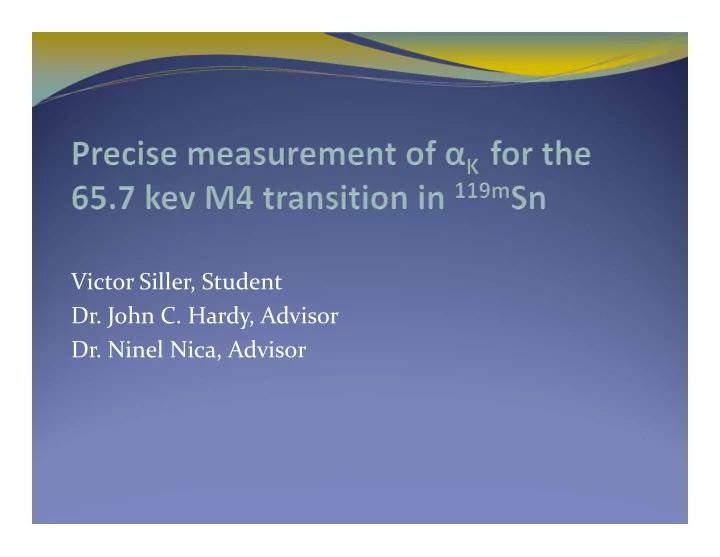

Victor Siller, Student Dr. John C. Hardy, Advisor Dr. Ninel Nica, Advisor
Overview Internal Conversion Theories Detection Background Shielding Spectral Analysis of 119m Sn Impurity analysis K x ‐ ray and γ‐ ray analysis α K Calculations Preliminary Results Summary
Internal Conversion When a nucleus is an excited state, it can decay to a lower energy state by gamma ( γ ) emission. Internal conversion is the process by which the a transition liberates an atomic electron rather that a photon
Internal Conversion Internal conversion can also occur without the emission of γ‐ ray. In this process the de ‐ excitation energy is transferred to one of the atomic electrons, and this electron is ejected from the atom Conservation of energy requires that the kinetic energy of the emitted electron be the difference in the energy of the nuclear state and the electron binding energy, T e =E γ‐ B n.
Internal Conversion • Whenever an electron is ejected out, it creates a vacancy that need to be filled. • A electron from an outer shell moves down to fill this vacancy and an x ‐ ray is emitted.
Theories We have determined that some of the Internal conversion coefficients ( α ) are relatively imprecise. We investigate internal conversion to test the theory of whether the vacancy in the atomic shell gets filled or not. Measuring the α K for the 65.7 keV transition in 119m Sn allows us to test the importance of including the atomic vacancy in the calculation of the ICC since, in this case, α K =1618 if the vacancy is included and α K =1543 if it is not.
Detection We use a High Purity Germanium crystal detector (HPGe) that is capable of detecting x ‐ rays and γ‐ rays at ~8 keV and up The efficiency of the detector is ±.15% from 50 ‐ 1800 keV
Source Background Shielding In our efforts to reduce the • For our experiment we used 119m Sn, amount of background which had been produced by neutron radiation we use three outer activation of enriched 118 Sn at the Pb cylinders, one inner Cu Texas A&M TRIGA reactor. cylinder, and a Cu back shield. The Cu was used to absorb x ‐ rays from the Pb • For the preliminary measurements we activated for only 16 hours. The Each cylinder has a source was relatively weak, so we thickness of ~4 mm and a measured it at 79 mm as well as 151 length of ~175 mm. mm where the efficiency of the detector is known from the front of We manage to reduce the the detector. amount of background radiation by a factor of 5.
Spectral Analysis 119Sn_jul13_22_7 • For spectrum analysis, we used software called Maestro, which allowed us to view the counts as a function of energy. • Using Maestro, we obtained the area 119Sn_jul26_23_1 under the curve for two K x ‐ ray peaks at 25.12 keV and 29.57 keV, and the γ‐ ray peak at 65.7 keV. Background radiation was also taken into account and subtracted • Through the process of neutron activation, activities such as 117m Sn, 113 Sn, and 182 Ta were also created and these impurities were subtracted from our peaks of interest.
Spectra Analysis Calculations Area 25.12 keV 29.57 keV 65.7 keV (counts), (counts), (counts), K α K β 66 γ 151.0mm 2620714 615023 3106 79.0mm 7513840 1721786 9888 • The detector calibration is well known at Impurity Analysis 151 mm but the rate is higher at 79 mm. We used Monte Carlo calculations to obtain the relative efficiencies at the closer distance. 117M Sn 113 Sn (counts) 182 Ta (counts) Corrected (counts) at at 391.96 keV at 68.0 keV Efficiency 79.0mm 151.0mm 158.5 keV 25.19 keV 2.8773(14)% 0.9519(14)% 151.0mm 80600 12659 11320 28.57 keV 2.9451(14)% 0.9773(14)% 79.0mm 118860 30040 24575 65.66 keV 3.0696(14)% 1.0224(14)% 67.75 keV 3.0623(14)% 1.0201(14)% 158.56 keV 2.4859(14)% 0.8562(14)% 361.69 keV 1.3917(14)% 0.4714(14)%
Preliminary Results • The results for different distances were later combined with others to give the result 1600(300). • ω K =0.860(4), Fluencies Yield 117m Sn 113 Sn 182 Ta [66 γ ] [Imp 1] [Imp 2] Percent ~2.2% ~0.6% ~20.6% Corrected I Sn Kx I 66 γ I Sn Kx I 66 γ α K (Imp 1) (Imp 2) (corrected) At 313592951 267532 389850000 267000 1698 79.0mm At 3382338 3038 3268000 2521 1507 151.0mm
Preliminary Results Although Maestro is quite user friendly, it is limited in the evaluation of peak • areas. It does not allow a precise fit to the background under each peak. This also affects the precision with which background peaks can be subtracted. The location we used for our measurement left much to be desired. The • detector was located on top of the shielding blocks above the MARS spectrometer and, when that device was in use, the background activities increased.
Conclusion Despite its large uncertainty, our result points the way to a more precise • measurement in future. A new 119m Sn source is being prepared with a much longer neutron • activation. We will also use a different location for the measurement. The Radware code will be used to do the data analysis. This software • allows the user to fit individual peaks and background in a more precise and reproducible way.
Acknowledgments A Special Thanks to • Dr. John C. Hardy • Dr. Ninel Nica • The National Science Foundation • The Department of Energy • Texas A&M Cyclotron Institute
Recommend
More recommend